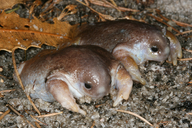|
Myobatrachus gouldii (Gray, 1841)
Turtle Frog | family: Myobatrachidae subfamily: Myobatrachinae genus: Myobatrachus |
 © 2014 Ryan J. Ellis (1 of 2) |
|
|
|
Description Its overall coloration varies from light pink to dark brown with its limbs and ventral side often lighter colored. Distribution and Habitat Country distribution from AmphibiaWeb's database: Australia
Life History, Abundance, Activity, and Special Behaviors Breeds after heavy rain that triggers emergence. Males call from the soil surface or with only their heads uncovered from September-February (spring to late summer). Vertucci et al (2017) described the calls of Myobatrachus gouldii and compared with other myobatrachids Arenophryne rotunda and Metacrinia nichollsi, finding the calls highly conservative. Both the male and female burrow together although amplexus has not been witnessed; Anstis et al (2007) reports they remain together until autumn eggs are laid. Eggs are very large and up to 40 are laid about 80-115 cm or up to 1 – 1.2 m underground (Anstis et al 2007; Vertucci et al 2017). Development is terrestrial and occurs within the egg capsule (Roberts 1981). Larva Trends and Threats Comments Frogs have a unique spine that is shorter than most other tetrapods to provide axial rigidity for efficient jumping. Adler et al. (2022) measured the shape of the presacral vertebrae among more than 200 frog species to examine how the individual bones within the spine have evolved over the more than 200 million years of frog evolution. They discovered high evolutionary rates in the cervical vertebrae and in the more caudal trunk vertebrae but little evidence for selection pressures related to adult or larval ecology. However, they found body size was highly associated with vertebrae shape and microhabitat (especially burrowing) affected those allometric relationships. Their results differ from patterns of vertebrae evolution in other clades, such as mammals, and serve as a jumping-off point for studies of anuran vertebrae evolution and development. (Written by Molly Womack) This species was featured in News of the Week 6 November 2023: Australia is generally considered hot, dry, and flat, making it an apparently inhospitable place for frogs. Despite this, more than 250 species call the continent home, ranging from enormous green tree frogs, to tiny brown burrowing frogs. But where did Australia’s frogs come from and when did they get there? A study by Brennan et al. (2023) provides insight into the origins of Australia’s frogs, giving age estimates to the three major frog groups found on the continent (Myobatrachoids, Pelodryadidae treefrogs, Asterophryinae microhylids) and establishing their closest relatives. This new Australian frog tree-of-life highlights the amazing adaptive potential of frogs. This includes fully aquatic and burrowing "treefrogs", and the wonderful and bizarre turtle frog Myobatrachus gouldii. In retracing the history of Australia's frogs, they find that the oldest groups such as myobatrachids, limnodynastids, and pelodryadids likely originated from Gondwana before the separation of the Australian continent. In comparison, the youngest group (microhylids) likely immigrated to Australia from New Guinea just over 10 million years ago. Finally, they provide evidence from biogeographic modelling that Australia's tree frogs arrived via dispersal from South America through Antarctica, challenging previous hypotheses regarding long distance overwater dispersal. (Written by Ian Brennan)
References
Anstis, M., Roberts, J. D., & Altig, R. (2007). "Direct development in two myobatrachid frogs, Arenophryne rotunda Tyler and Myobatrachus gouldii Gray, from Western Australia." Records-Western Australian Museum, 23(3), 259-271. [link] Barker, J., Grigg, G. C., and Tyler, M. J. (1995). A Field Guide to Australian Frogs. Surrey Beatty and Sons, New South Wales. Cogger, H.G. (1992). Reptiles and Amphibians of Australia. Reed Books, New South Wales. Roberts, J.D. (1981). ''Terrestrial breeding in the Australian Leptodactylid frog Myobatrachus gouldii (Gray).'' Australian Wildlife Research, 8, 451-462. Tyler, M.J., Smith, L.A., and Johnstone, R.E. (1994). Frogs of Western Australia. Western Australian Museum, Perth. Vertucci S, Pepper M, Edwards DL, Roberts JD, Mitchell N, Keogh JS (2017). "Evolutionary and natural history of the turtle frog, Myobatrachus gouldii, a bizarre myobatrachid frog in the southwestern Australian biodiversity hotspot." PLoS ONE, 12(3), e0173348. [link] Originally submitted by: Jean-Marc Hero et. al. (first posted 2002-04-05) Description by: Michelle S. Koo (updated 2022-08-21)
Life history by: Michelle S. Koo (updated 2022-08-21)
Larva by: Michelle S. Koo (updated 2022-08-21)
Edited by: Ambika Sopory, Michelle S. Koo (2023-11-05) Species Account Citation: AmphibiaWeb 2023 Myobatrachus gouldii: Turtle Frog <https://amphibiaweb.org/species/3578> University of California, Berkeley, CA, USA. Accessed Jun 15, 2025.
Feedback or comments about this page.
Citation: AmphibiaWeb. 2025. <https://amphibiaweb.org> University of California, Berkeley, CA, USA. Accessed 15 Jun 2025. AmphibiaWeb's policy on data use. |


 Map of Life
Map of Life